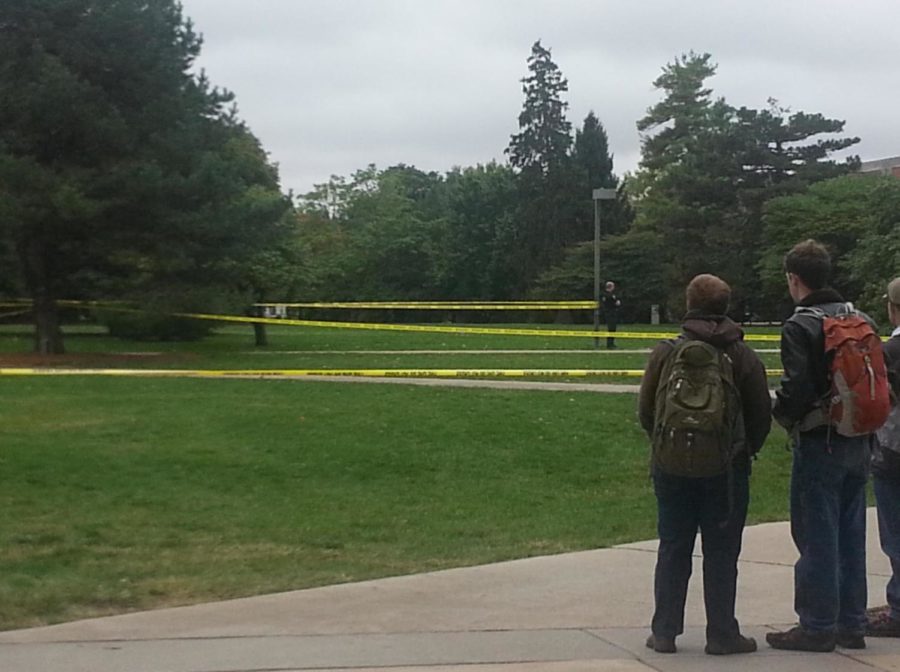ISU Police use social media to inform about suspicious object found near library
Students look out across the blocked off area, early in the investigation of a suspicious item found on campus.
October 17, 2013
The ISU Police Department is facing both positive and negative responses from ISU students for its use social media to update students, faculty and staff of a suspicious item found Wednesday morning near Parks Library and the Hub.
Darin Van Ryswyk, investigations captain for ISU Police, said the object looked like a “cylindrical item about the size of a water bottle in a grayish-greenish sock.”
The Hub was evacuated, and a large portion of the sidewalks and grass between Parks Library, Durham Hall and the Hub was taped off. Following standard protocol, the bomb squad from the Iowa State Fire Marshal Division was called in to remove the object.
On Wednesday afternoon, ISU Police confirmed the object was not explosive and was in fact a hollow piece of Styrofoam encased in a sock. A member of the student organization Tir Asleen Medieval Combat Society identified the object as something they had used the night before.
Both Van Ryswyk and Annette Hacker, director of ISU News Service, said ISU Police suspected early on the object might belong to the student organization, but they had to follow protocol.
A little before 10:30 a.m., officer Anthony Greiter tweeted through the ISU Police Twitter handle that there was a suspicious object and that students should avoid the affected area. ISU Police also posted frequent updates on Twitter and their Facebook page. The ISU emergency alert system was not used.
“It’s used when there’s an immediate, continued, sustained threat to the campus community. The chief of police decides when that kind of timely warning is warranted,” Hacker said “This situation just didn’t fit the criteria of an ISU Alert, because it was not an immediate threat. That’s not to say we might not have used ISU Alert had the situation changed.”
Van Ryswyk said the location of the incident played into the fact that an alert was not used.
“This was a small item in a very controllable area of campus, so instead of alarming all 34,000 of us plus faculty and staff, let’s just isolate this area,” Van Ryswyk said. “The alert was the tape and the officers.”
Van Ryswyk also said ISU Police received criticism for not using the ISU Alert system and not notifying the large number of people on the alert system.
Hacker said, however, that ISU Police and university administration do not want to overuse the alert system and desensitize students.
“It’s a lose-lose situation: When the fire alarm goes off, people tend to think it’s a false alarm,” Van Ryswyk said. “We don’t want them to ever think that ISU Alert is a false alarm,”
Katie Larkin, senior in child, adult and family services, said she heard about the incident through a notification on the ISU website that led her to ISU Police’s Twitter page.
“I think they did a good job at keeping everyone updated,” Larkin said.
But Larkin did say she would have appreciated an emergency alert.
“I think if they call in a bomb squad, the whole university should have been notified,” she said. “I think by not notifying, they almost caused more of a panic just because no one knew what was going on. They just saw the bomb squad van.”
Emma Welch, senior in psychology, said she was surprised by the absence of an emergency alert. Welch said she was in the Hub when it was evacuated at about 10:30 a.m. She received information from Facebook, Twitter and the Iowa State Daily. Welch also said she posted her own updates from behind the yellow tape.
As for the use of social media to inform students and staff about the emergency, Van Ryswyk said it has been a helpful tool in solving investigations.
“Social media is going to move beyond our control, so we have to work with it. We can’t stop rumors. We can’t stop false information. We can send out correct information,” Van Ryswyk said. “I made the decision to put it out there and see if anyone recognizes it.”
Van Ryswyk said he would like to thank the community for being so understanding and respectful in cooperating with ISU Police. He also said he would like to remind students that if they see a suspicious item, contact the police immediately.
“It’s better safe than sorry,” Van Ryswyk said.







